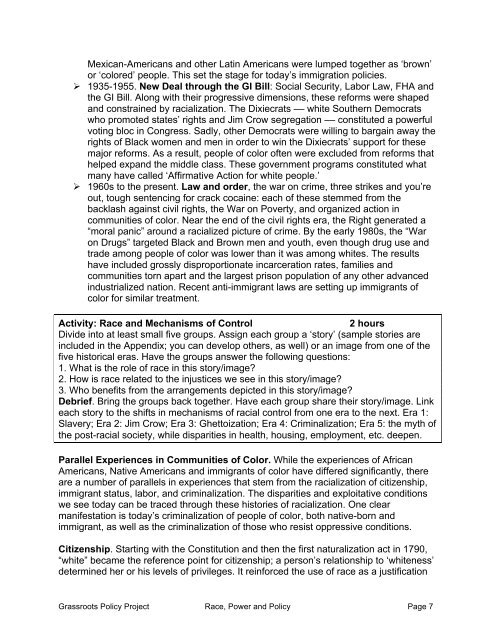Institutional Racism
Institutional Racism
Institutional Racism
You also want an ePaper? Increase the reach of your titles
YUMPU automatically turns print PDFs into web optimized ePapers that Google loves.
Mexican-Americans and other Latin Americans were lumped together as ‘brown’<br />
or ‘colored’ people. This set the stage for today’s immigration policies.<br />
! 1935-1955. New Deal through the GI Bill: Social Security, Labor Law, FHA and<br />
the GI Bill. Along with their progressive dimensions, these reforms were shaped<br />
and constrained by racialization. The Dixiecrats –– white Southern Democrats<br />
who promoted states’ rights and Jim Crow segregation –– constituted a powerful<br />
voting bloc in Congress. Sadly, other Democrats were willing to bargain away the<br />
rights of Black women and men in order to win the Dixiecrats’ support for these<br />
major reforms. As a result, people of color often were excluded from reforms that<br />
helped expand the middle class. These government programs constituted what<br />
many have called ‘Affirmative Action for white people.’<br />
! 1960s to the present. Law and order, the war on crime, three strikes and you’re<br />
out, tough sentencing for crack cocaine: each of these stemmed from the<br />
backlash against civil rights, the War on Poverty, and organized action in<br />
communities of color. Near the end of the civil rights era, the Right generated a<br />
“moral panic” around a racialized picture of crime. By the early 1980s, the “War<br />
on Drugs” targeted Black and Brown men and youth, even though drug use and<br />
trade among people of color was lower than it was among whites. The results<br />
have included grossly disproportionate incarceration rates, families and<br />
communities torn apart and the largest prison population of any other advanced<br />
industrialized nation. Recent anti-immigrant laws are setting up immigrants of<br />
color for similar treatment.<br />
Activity: Race and Mechanisms of Control<br />
2 hours<br />
Divide into at least small five groups. Assign each group a ‘story’ (sample stories are<br />
included in the Appendix; you can develop others, as well) or an image from one of the<br />
five historical eras. Have the groups answer the following questions:<br />
1. What is the role of race in this story/image?<br />
2. How is race related to the injustices we see in this story/image?<br />
3. Who benefits from the arrangements depicted in this story/image?<br />
Debrief. Bring the groups back together. Have each group share their story/image. Link<br />
each story to the shifts in mechanisms of racial control from one era to the next. Era 1:<br />
Slavery; Era 2: Jim Crow; Era 3: Ghettoization; Era 4: Criminalization; Era 5: the myth of<br />
the post-racial society, while disparities in health, housing, employment, etc. deepen.<br />
Parallel Experiences in Communities of Color. While the experiences of African<br />
Americans, Native Americans and immigrants of color have differed significantly, there<br />
are a number of parallels in experiences that stem from the racialization of citizenship,<br />
immigrant status, labor, and criminalization. The disparities and exploitative conditions<br />
we see today can be traced through these histories of racialization. One clear<br />
manifestation is today’s criminalization of people of color, both native-born and<br />
immigrant, as well as the criminalization of those who resist oppressive conditions.<br />
Citizenship. Starting with the Constitution and then the first naturalization act in 1790,<br />
“white” became the reference point for citizenship; a person’s relationship to ‘whiteness’<br />
determined her or his levels of privileges. It reinforced the use of race as a justification<br />
Grassroots Policy Project Race, Power and Policy Page 7

















